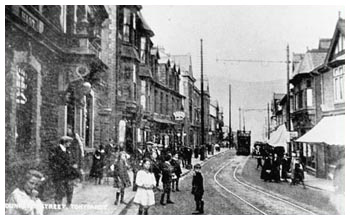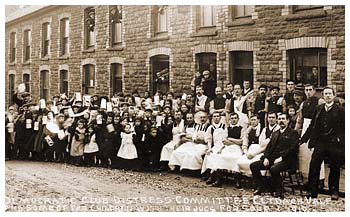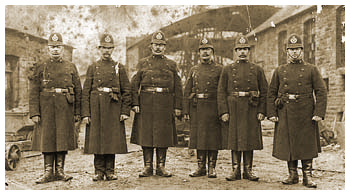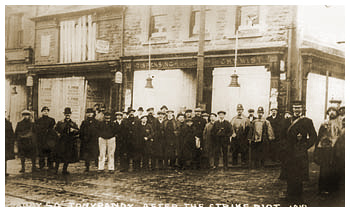
| Tonypandy | |
Dunraven Street Circa 1920
|
An English translation of the name Tonypandy is ‘the meadow of the fulling mill'. E.D. Lewis in his work ‘The Rhondda Valleys' provides us with an outline history of the mill that once stood in Tonypandy, and from which the town took its name. He describes how, ‘The woollen manufactring and the pandy or fulling mill were situated on Nant Clydach, near the confluence of the Clydach brook and the River Rhondda Fawr at Tonypandy'. He further describes how the mill dates back to 1738 and was established by Harri David, and was run in the second half of the eighteenth century by David Martin. An English translation of the name Tonypandy is ‘the meadow of the fulling mill'. E.D. Lewis in his work ‘The Rhondda Valleys' provides us with an outline history of the mill that once stood in Tonypandy, and from which the town took its name. |
The 1847 tithe map of the area around Tonypandy shows how the area, possibly because of importance of the mill as a centre for local farmers, contained in addition to the usual scattered farmhouses a number of cottages as well as a shop. Mines were sunk at Tonypandy, such as Nantgwyn on the hillside above Tonypandy in 1892, and Gellifaelog sunk by Walter Coffin in 1845. |
|
| However Tonypandy's importance came more from its position as a commercial and cultural centre for the surrounding villages. The first free library in the Rhondda was set up in Tonypandy above a furniture shop in Dunraven Street, and theatres such as the Empire Theatre of Varieties and the Theatre Royal thrived in the last half of the nineteenth and early part of the twentieth century. Tonypandy also boasted the substantial Methodist Central Hall for many years, a substantial and impressive building. Originally known as the Wesleyan Central Hall it was erected in 1923 at a cost of £27,000 and contained a main hall capable of seating 1,000, as well as suites of rooms and a lesser hall, which sat 500. |
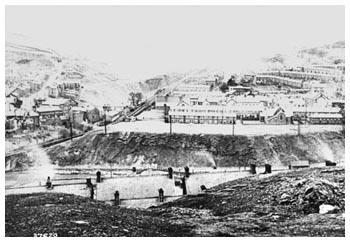 |
| Additionally the town had a secondary school erected in 1915 which later became its grammar school, a Roman Catholic church and elementary school, a main police station which in 1926 had a compliment of three sergeants and ten constables. For many years a fountain and water trough, known locally as ‘The Lady with the Lamp', graced Tonypandy square. This fountain and statue was erected in 1909 with money left over from the memorial statue to Archibald Hood the well-known Scottish engineer and local mine owner. Tonypandy is best known as the place of the 1910 Tonypandy Riots, which led to the Metropolitan Police and military units being stationed in the Rhondda, following disturbance during the Cambrian Colliery Dispute. |
|
| The Cambrian Colliery Dispute (The Tonypandy Riots) | |
| In the early twentieth century the Cambrian Combine was one of the most powerful entities in the coal industry in the Rhondda. The clash between this power wielded by the coal owners in the shape of the Combine and that of the workers in the form of the Cambrian Lodge of the South Wales Miners Federation led to one of the bitterest disputes in South Wales' industrial history. Ultimately this dispute led to the incident that has become known in popular history as 'The Tonypandy Riots'. The dispute originated at the Combines' Ely Pit in Penygraig, owned by the Naval Colliery Company and centred on the management's decision to open up a new seam, the Upper Five Foot or Bute seam. Prior to opening a new seam a test period was mined at the seam to determine its output, and a price was set per ton for the miners who would work the seam. During the test period at this seam in 1909 management alleged workers had deliberately worked slower than they were able, in order to raise the price per ton of the seam when it was actually in production. The workers on their part alleged that it was a particularly difficult seam to work with many 'abnormal places'. Finally the management offered 1s.9.d per ton for workers mining the seam, whereas workers demanded 2s.9.d, arguing that at the price offered they would not be able to mine enough coal to make a reasonable wage. |
|
Democratic Club Distress Committee 1910 |
The two sides in the dispute were deadlocked, and on August 1st 1910 the colliery owners posted lockout notices, not just for the 80 men affected by the dispute over the seam, but for all 800 men employed at the colliery. The lockout began on September 1st 1910. On September 5th the workmen at two other Naval pits came out on strike in sympathy with the workers at Ely Pit, and the other Cambrian and Glamorgan Collieries' workers voted on September 7th to follow a week later. At that time William Abraham MP (Mabon) dissuaded them from this course of action after promising the men a coalfield wide conference to address the issues of the dispute. |
| At an Executive Council of the South Wales Miners Federation held on September 16th it was recommended that; ' the conference tomorrow to agree that the whole of the workmen employed at the Cambrian Combine be given permission to tender their notices upon the 1st of October next, to terminate their contracts and that a weekly levy be made upon all members of the Federation to provide necessary financial support'. | |
| The conference was held next day at Cory hall with 248 delegates representing over 147,000 men and a decision was made to ballot on whether to accept this recommendation or if all the members of the Federation should strike in sympathy with the Cambrian workers. The vote was in favour of providing support for the Cambrian strikers. All workers within the Cambrian combine duly gave the period of notice whilst frantic moves went on to prevent an all out strike. Mabon himself secured an increased offer of 2s1.3d a ton but the Cambrian Lodge also rejected this offer. At the same time D.A Thomas, head of the Combine, attended a meeting of the powerful Coal Owners association in Cardiff, at which time the owners pledged an indemnity to owners of affected pits as well as a promise not to employ striking miners elsewhere within the coalfield. |
Bangor police stationed at Clydach Vale 1910/11
|
| Thus with battle lines drawn and a hardening of attitudes on both side the strike officially began on the 1st November 1910. The coal owners immediately drew up plans to import labour into the coalfield, and expecting trouble asked the Chief Constable of Glamorgan, Captain Lionel Arthur Lindsay, for increased police protection. This request was acceded to and extra police were drafted in from Swansea, Cardiff and Bristol. On the miners side the Trade Disputes Act of 1906 gave them the right of 'peaceful picketing' and at a meeting on the 7th November the strikers declared 'we intend to prevent any officials from Mr.Llewellyn downward from entering the colliery yards'. Given such an inflammatory mix of thousands of pickets, the threat of imported labour, and increased police presence in the community, together with the ill feeling already engendered by the lockout and strike, trouble was perhaps inevitable. Indeed that Autumn of 1910 was one of the most volatile the mining industry had yet seen, strikes had already broken out in other parts of the coalfield such as Aberdare, and by November nearly one sixth of all miners in South Wales were on strike.The miners had decided that at 5a.m. on the 7th November all striking miners should demonstrate at their respective pits. At shortly after 5a.m Noah Rees, secretary of the Cambrian Lodge together with W.H.Mainwaring and a 'trumpeter' went through the streets calling the miners to action. In order to prevent anyone from attending work that day, strikers as well as congregating at the entrances to the mines also took up station at all the streets and lanes leading to the mines in order to turn back anyone attempting to get to work |
|
Tonypandy Square after the riots 1910
|
Miners' wives and children joined their husbands and fathers on this picket duty. The miners' campaign was successful, with work being prevented at all but one of the Cambrian Combine pits, namely the Glamorgan Colliery at Llwynypia which Leonard Llewellyn, its manager, had turned into a 'Fortress'. In addition to picketing to prevent any access to the collieries, miners also forced their way into the Cambrian colliery in order to put out the boiler fires and stop the ventilation fans, thus preventing anyone working in the colliery. |
By 10.30 p.m. that evening the one working pit of the Cambrian Combine, Llwynypia was surrounded by striking miners, inside was Leonard Llewellyn, and around sixty officials and draughtsmen of the colliery keeping the machinery of the pit working and the mine free from water. Rumours outside had it that Llewellyn had imported stokers from Cardiff who were acting as 'blackleg' labour. In addition to the workers manning the colliery, the premises also contained Captain Lindsay and over one hundred policeman. This concentration of manpower at Glamorgan Colliery is a testament to the importance of the site to both sides of the dispute, containing as it did the electric generator and pumping station that kept the mines free from water. It was at this power station that the strikers had their first brush with the law, and the events that were subsequently known as the Tonypandy Riots really began. Although the crowd, by now numbering in the thousands on the most part listened to their leader, Will John, and his appeal for calm. A small percentage of the crowd lining the embankment above the power station began stoning the building below and some of the wooden fencing surrounding the colliery was pulled down. Serious disorder ensued with the police and strikers involved in hand to hand fighting, finally the police after repeated baton charges succeeded in driving the crowd away from the colliery site towards Tonypandy just after midnight. At Tonypandy square, between 1 and 2 a.m., fifty constables from Cardiff used truncheons to further disperse the crowds that had subsequently gathered there. 'All the Cambrian collieries menaced last night. The Llwynypia Colliery savagely attacked by large crowds of strikers causing many casualties on both sides. Am expecting two companies of infantry and 200 cavalry today.' Unbeknownst to him however, Churchill on finding out about the unapproved troop movements had already stopped the reinforcements at Swindon, fearing some said a repeat of the incidents of 'Bloody Sunday, when in 1887 at Trafalgar Square troops with fixed bayonets faced rioters. He sent a telegram to Lindsay stating, 'infantry should not be used until all other methods have failed'. Instead of the military he sent 70 mounted and 200 other constables of the Metropolitan Police Force as reinforcements to the authorities already in the area. Cavalry were also offered, to be sent into the district as a precautionary measure under the control of General MacReady. Lindsay on hearing of the contingent of Metropolitan Police being sent to his aid refused the use of the cavalry saying the police reinforcements should be sufficient, as such the cavalry were halted at Cardiff. On Tuesday the 8th November the workmen on strike were paid off by the companies of the Cambrian Combine and proceeded to the Tonypandy Athletic Ground for a mass meeting. The local stipendiary magistrate Lleufer Thomas spoke to the men and read out a message from the Home Secretary who maintained his intent to hold back the soldiers and send only police in to maintain the peace. The tone was conciliatory and was well received by the strikers, promising as it did to arrange meetings with the Board of Trade to resolve the dispute. The miners then formed an orderly procession and proceeded once again to the Glamorgan Colliery, arriving about 4p.m. Within the hour however what was described as 'serious rioting' had once again occurred. Mounted police attempted to disperse the strikers and hand to hand combat between strikers and the police took place lasting over two hours. Finally the police managed to split the strikers into separate groups, some being driven up the valley towards Llwynypia and others down the valley towards Tonypandy. Scores of not hundreds of police and rioters were left injured. It was what happened next that has gone down in history as the Tonypandy Riots. Strikers on being driven to Tonypandy proceeded to smash the shop windows of the town, and also those of a number of private dwellings. Contemporary reports state that of all the shopping district only two shops retained their windows and were not looted by the rioters, one a jewellers which had roller shutters and the other a chemist owned by a former Welsh rugby International. The five constables on duty in Tonypandy at the time, together with dozen reinforcements from the Colliery finally managed to clear the streets. Due to the seriousness of this continued rioting Churchill telegrammed General MacReady stating, 'As the situation appears to have become more serious you should if the Chief Constable or Local Authority desire it move all the cavalry into the district without delay'. Churchill also spoke to Lindsay and MacReady and agreed to send another contingent of 200 Metropolitan policemen leaving London on Wednesday 9th November at 3a.m. However by the time that 150 police arrived at Tonypandy Square at 11p.m. on the Tuesday 8th November the disturbances were over. Although no authentic record exists of casualties of these disturbances, as many of the miners would have refused treatment in fear of being prosecuted for their part in the riots, nearly 80 policemen were injured and over 500 other persons, one Samuel Rhys later dying of his injuries. |
|
| TONYPANDY METHODIST CENTRAL HALL | |
| The Methodist Central Hall dominated the lower end of Tonypandy for over sixty years from its opening in 1923 until its eventual demolition in 1985. Methodist Central Halls were designed to meet not only the spiritual needs of the population but also to serve as social and educational centres for the communities they served. The Glamorgan Free Press and Rhondda Leader newspaper of Friday June 29th 1923 describes the opening of the new hall, which it calls, ‘The Most Beautiful Hall in Wales'. It describes how the Hall built by Messrs. Laing and Sons, at a cost of £30,000, and designed by architect Mr. Arthur Brocklehurst was formally opened by Lady Nicholas of ‘The Garth', Trealaw accompanied by her husband Sir Walter Nicholas. Huge crowds attended the event so much so that, ‘The street was dense with people when the opening ceremony was performed, traffic for the time having to be suspended'. The Rev.J.E. Wakerley the President of the Wesleyan ‘connexion', performed the dedicatory service, and a great public meeting was held in the main hall of the building presided over by Mr. Joseph Rank of Hull, donor of £10,000 to the building fund. Prior to the establishment of the Central Hall the Methodist cause already had a long history in the area. It began in a large room over ‘Y Siop Fawr' in Dinas and later moved to Penygraig, where services and Sunday School were held in the Long Room of the White Hart Hotel. Then in 1866 a plot of land was secured from Gellifaelog Farm in Tonypandy upon which the first chapel on the site was built. This chapel was small and could cater for only eighty worshippers and thus was soon shown to be inadequate for the needs of the local Methodists. Thus a new, enlarged chapel was erected on the site in 1873, which itself was enlarged in 1899 and in which a gallery was erected in 1910. This chapel was in turn demolished in 1922 to make way for the new Central Hall, which took a year to build. During this time the worshippers held services at Judges Hall as well as the vestries of Seion and Ebenezer Chapels, additionally prayer meetings were held in the front bedroom of the caretaker's house. The Central Wesleyan Hall, as it was originally known, consisted of a main hall capable of seating 1,000 people, a choir platform that accommodated 100 choristers, and a lesser hall with a capacity for 400 people. It also boasted a ‘primary department' with accommodation for 150 children and five or six classrooms, as well as a games room with two billiard tables, a library and a place for reading and writing. As stated in the Central Hall's twenty-fifth anniversary booklet , ‘ Within a few short years [after the completion of the building] the valley was in a grip of a depression that crippled its life', during this troubled time the Hall, under the leadership of the Rev.R.J.Barker and later the Rev.C.E.Gwyther, ‘Stood as a light in the dark'. It became a ‘centre of mutual service' for the unemployed with woodworking and bootmaking workshops, reading rooms a printing press and a milk bar, also thousands of toys were made for distribution to local children, clothing was distributed and the canteen began to serve ‘twopenny meals'. The Hall also served a valuable function as a rest centre for evacuees during the Second World War. In common with many Rhondda Chapels the Hall faced a serious decline in the latter half of the twentieth century with dwindling congregations eventually forcing it to close in 1980. As the Rhondda Leader of Friday June 6th 1980 reported, ‘ Final Hymn sung at Central Hall…Another Rhondda Chapel closed its doors last week.' As a spokesman for the Hall at the time stated, ‘Up until the last ten years it was also a leading influence in the community until…a combination of industrial decline and decreasing interest in religion led to a dwindling membership'. The remaining eighty strong congregation transferred to other Methodist chapels. Mr. George Thomas, Speaker of The House of Commons, later Viscount Tonypandy, a former member and Trustee of the Hall attended the final service. In 1985 the Hall, which had been left derelict and vandalised for some five years, was eventually demolished to make way for a new supermarket. |
|
